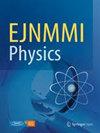Feasibility of 177Lu activity quantification using a small portable CZT-based gamma-camera
IF 3.2
2区 医学
Q2 RADIOLOGY, NUCLEAR MEDICINE & MEDICAL IMAGING
引用次数: 0
Abstract
In image processing for activity quantification, the end goal is to produce a metric that is independent of the measurement geometry. Photon attenuation needs to be accounted for and can be accomplished utilizing spectral information, avoiding the need of additional image acquisitions. The aim of this work is to investigate the feasibility of 177Lu activity quantification with a small CZT-based hand-held gamma-camera, using such an attenuation correction method. A previously presented dual photopeak method, based on the differential attenuation for two photon energies, is adapted for the three photopeaks at 55 keV, 113 keV, and 208 keV for 177Lu. The measurement model describes the count rates in each energy window as a function of source depth and activity, accounting for distance-dependent system sensitivity, attenuation, and build-up. Parameter values are estimated from characterizing measurements, and the source depth and activity are obtained by minimizing the difference between measured and modelled count rates. The method is applied and evaluated in phantom measurements, in a clinical setting for superficial lesions in two patients, and in a pre-clinical setting for one human tumour xenograft. Evaluation is made for a LEHR and an MEGP collimator. For phantom measurements at clinically relevant depths, the average (and standard deviation) in activity errors are 17% ± 9.6% (LEHR) and 2.9% ± 3.6% (MEGP). For patient measurements, deviations from activity estimates from planar images from a full-sized gamma-camera are 0% ± 21% (LEHR) and 16% ± 18% (MEGP). For mouse measurements, average deviations of − 16% (LEHR) and − 6% (MEGP) are obtained when compared to a small-animal SPECT/CT system. The MEGP collimator appears to be better suited for activity quantification, yielding a smaller variability in activity estimates, whereas the LEHR results are more severely affected by septal penetration. Activity quantification for 177Lu using the hand-held camera is found to be feasible. The readily available nature of the hand-held camera may enable more frequent activity quantification in e.g., superficial structures in patients or in the pre-clinical setting.使用基于 CZT 的小型便携式伽马相机量化 177Lu 放射性活度的可行性
在活动量化的图像处理中,最终目标是生成一个独立于测量几何的度量。光子衰减需要考虑在内,可以利用光谱信息来实现,从而避免了额外的图像采集。这项工作的目的是利用这种衰减校正方法,研究使用小型 CZT 手持伽马相机量化 177Lu 放射性活度的可行性。以前提出的双光峰方法是基于两种光子能量的不同衰减,现在针对 177Lu 在 55 千伏、113 千伏和 208 千伏的三个光峰进行了调整。测量模型将每个能量窗口中的计数率描述为源深度和活性的函数,并考虑了与距离相关的系统灵敏度、衰减和堆积。参数值根据特征测量结果估算,源深度和放射性活度则通过最小化测量计数率与模型计数率之间的差值来获得。该方法在模型测量、两名患者浅表病变的临床环境以及一种人体肿瘤异种移植的临床前环境中得到应用和评估。对 LEHR 和 MEGP 准直器进行了评估。在临床相关深度的模型测量中,活动误差的平均值(和标准偏差)为 17% ± 9.6%(LEHR)和 2.9% ± 3.6%(MEGP)。对于病人的测量,与全尺寸伽马相机平面图像的活动估计值的偏差为 0% ± 21%(LEHR)和 16% ± 18%(MEGP)。在小鼠测量中,与小动物 SPECT/CT 系统相比,平均偏差为-16%(LEHR)和-6%(MEGP)。MEGP 准直器似乎更适合进行活性定量,其活性估计值的变化较小,而 LEHR 的结果受隔膜穿透的影响更大。使用手持照相机对 177Lu 进行放射性活度量化是可行的。手持式照相机的易用性使其可以更频繁地对病人或临床前环境中的浅表结构等进行放射性活度定量。
本文章由计算机程序翻译,如有差异,请以英文原文为准。
求助全文
约1分钟内获得全文
求助全文
来源期刊

EJNMMI Physics
Physics and Astronomy-Radiation
CiteScore
6.70
自引率
10.00%
发文量
78
审稿时长
13 weeks
期刊介绍:
EJNMMI Physics is an international platform for scientists, users and adopters of nuclear medicine with a particular interest in physics matters. As a companion journal to the European Journal of Nuclear Medicine and Molecular Imaging, this journal has a multi-disciplinary approach and welcomes original materials and studies with a focus on applied physics and mathematics as well as imaging systems engineering and prototyping in nuclear medicine. This includes physics-driven approaches or algorithms supported by physics that foster early clinical adoption of nuclear medicine imaging and therapy.
 求助内容:
求助内容: 应助结果提醒方式:
应助结果提醒方式:


